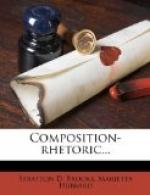+94. Importance of Good Letter Writing.+—Letter writing is the form of written language used by most of us more frequently than any other form. The importance of good letter writing is therefore obvious. Business, personal, and social relations necessitate the writing of letters. We are judged by those letters; and in order that we may be considered businesslike, educated, and cultured, it is necessary that we should be able to write good letters, not only as regards the form but also as regards the subject-matter. The writing of good letters is often the means of securing desirable positions and of keeping up pleasant and helpful friendships. Since this form of composition plays so important a part in our lives and the lives of those about us, it is worthy of careful study.
The subject-matter is the most important part of the letter, but adherence to usages generally adopted is essential to successful letter writing. Some of these usages may seem trivial in themselves, but a lack of attention to them shows either ignorance or carelessness on the part of the writer, and the consequences resulting from this inattention are often anything but trivial. Applicants for good positions have been rejected either because they did not know the correct usages of letter writing, or because they did not heed them. In no other form of composition are the rules concerning form so rigid; hence the need of knowledge and carefulness concerning them.
+95. Paper.+—The nature of the letter determines to some extent our choice of paper. Business letters are usually written on large paper, about ten by eight inches in size, while letters of friendship and notes of various kinds are written on paper of smaller size. White or delicately tinted paper is always in good taste for all kinds of letters. The use of highly tinted paper is occasionally in vogue with some people, but failure to use it is never an offense against the laws of good taste. It is customary now to use unruled paper for all kinds of letters as well as for other forms of compositions. For letters of friendship four-page paper is preferred to that in tablet form. The order in which the pages are used may vary; but whatever the order is, it should not be confusing to the reader.
Black ink should always be used. The writing should be neat and legible. Attention should be paid to margin, paragraphs, and indentation. In fact, all the rules of theme writing apply to letter writing, and to these are added several others.
+96. The Beginning of a Letter.+—Certain forms for the beginning of letters have been agreed upon, and these forms should be followed. The beginning of a letter usually includes the heading, the address of the person or persons to whom the letter is sent, and the salutation.
Notice the following examples:—




